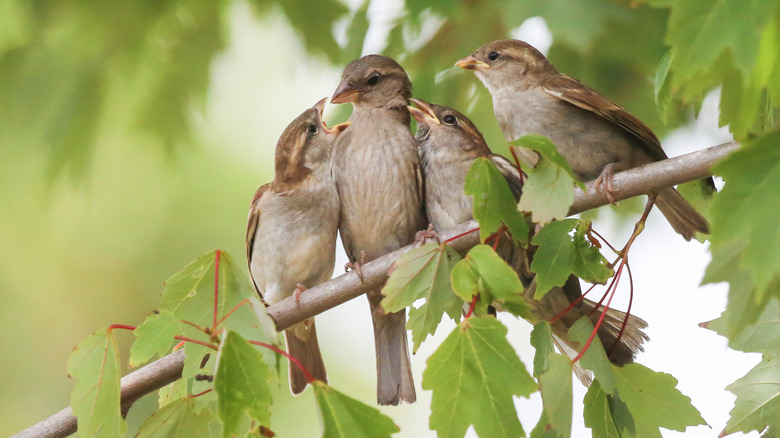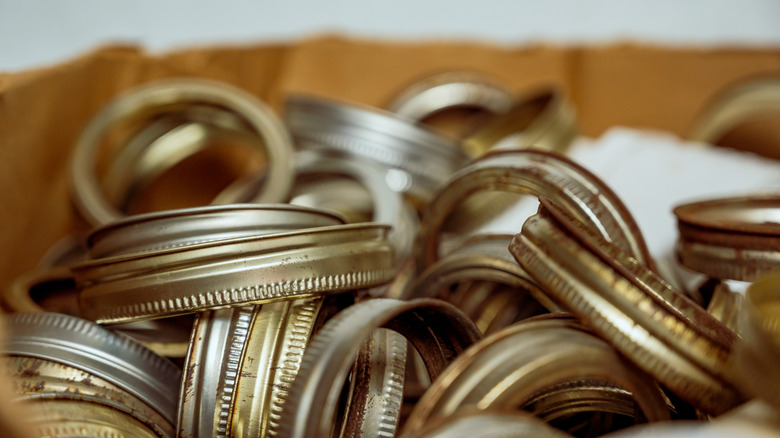This Jar Lid Bird Feeder DIY Will Have Birds Flocking To Your Yard
We may receive a commission on purchases made from links.
Passionate backyard bird watchers, do we have a family-friendly DIY bird feeder idea for you! All you need to create this easy-peasy hanging bird feeder is a roll of twine, some birdseed, some kind of sticky avian-friendly binder, a handful of Mason jar lids — the surrounds sans the inserts, and about half an hour out of your day. With Mason jars as home decor going out of style, you probably have a bunch of jars — and their distinctive lids — around the house already. Do you can? You likely have an entire drawer full of spare lids. If you don't, they're inexpensive to buy anyway.
The part of the lid you need to use for this project is called the "band" or "ring" — it's the hollow circle of metal or plastic that surrounds the flat insert. Ideally, go for wide-mouth canning jar lids. It's more efficient, time-wise, to fill a large lid. They also provide the biggest surface of seeds for birds to nibble from and suitable perching space. If you're buying new, you can get a box of 24 wide-mouth food-grade metal canning lids with rings for $14.99 on Amazon. Ace Hardware has a 4-pack of plastic Masontop bands for $13.99. Bonus: The plastic won't rust like the metal is prone to. Just want the rings? Get 24 tinplate bands for $10.99 from Walmart. Are you on a budget or prefer to upcycle? Thrift stores often have bundles of old canning jars — lids attached — for a few dollars.
Round up all the birdie banquet supplies
The birdseed mix you get depends on which species regularly visit your yard already or which species you wish to attract. For example, Duncraft has a 20-pound Chickadee Blend for $89.95. Likewise, head to For the Birds to buy an 8-pound bag of Meadow Ridge Farms Woodpecker Mix for $27.99. Love finches? A 3-pound bag of IDEAL Finch Mix is just $2.75 from Standish Milling. If you're just getting started, go for a mix designed to attract a wide variety of species. Home Depot sells a 20-pound wild birdseed mix containing milo, white millet, cracked corn, and sunflower seeds for $10.97. If you're on a budget or have a bit more time on your hands, you can also DIY your very own birdseed pretty easily.
You can use a bunch of different binders to stick all the seeds and grains together — all that matters is that it's safe for birds to eat regularly. Unflavored gelatin is often recommended by wild bird organizations, as is corn syrup. Using suet (firm-rendered animal fat) is a trickier prospect. If it melts, it gets all over birds' feathers, affecting their ability to fly. It can also go rancid. Never use suet-bonded seed cakes in weather above 80 degrees Fahrenheit. If it's hot outside, try natural peanut butter, one free from partially hydrogenated oil or trans fats, instead. Vegetable shortening, such as Crisco, is another option for those opposed to using animal by-products.
Start assembling your new avian food haven
Once you have your birdseed, jar lids, and binder of your choice, assemble a silicon cookie sheet or baking paper, sturdy twine, sharp scissors, and a large mixing bowl and spoon. Cut long lengths of twine, double them over the ring, and tie them tightly. (You'll trim any extra length after you hang them.) Lay the now-strung bands out on the cookie sheet or paper. Pour about three to four cups of birdseed mix into the large bowl — this will fill around 12 jar lids. Add three-ish tablespoons of your preferred binder, a packet of unflavored gelatin, and less than a cup of flour. A big dollop of peanut butter is optional.
Use a spoon or your hands to combine all the ingredients. The mixture should be really sticky. If it's hard to handle, rub some cooking oil onto your hands or keep a bowl of warm water handy to dip them in periodically. Press a small handful of the birdseed "dough" firmly into the first ring. There shouldn't be any gaps. Smooth off the dough so the mixture sits flush with the top edge of the lid, and repeat the process until all the bands are full. Leave the feeders to dry out overnight, or speed up the process by popping them in the fridge or freezer for a few hours. Once they've hardened, all that's left is to find the best place to hang a bird feeder in your yard.

